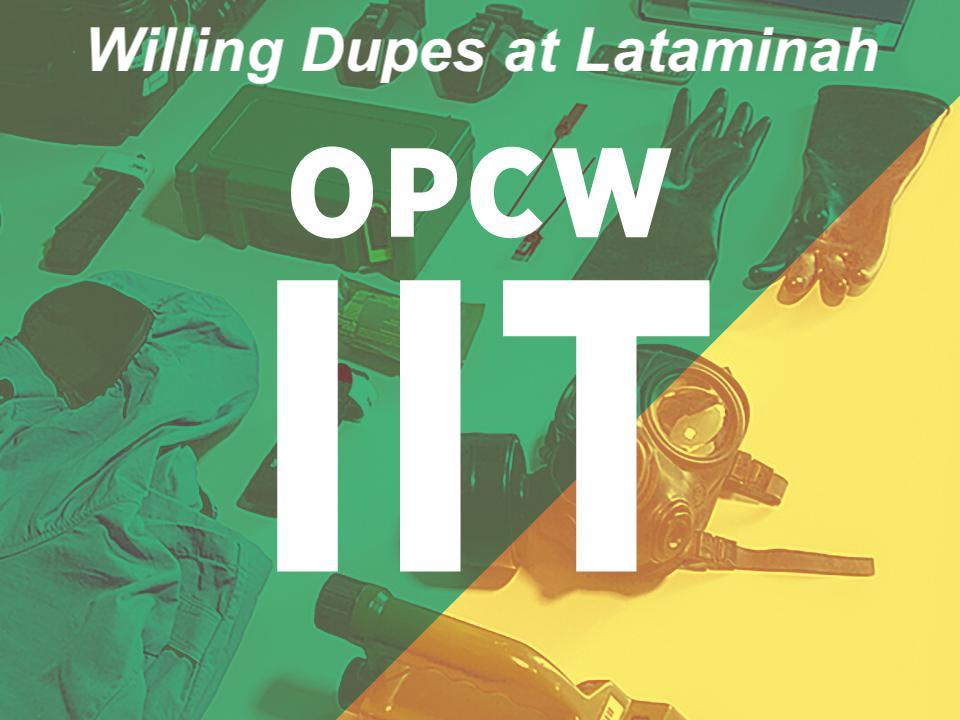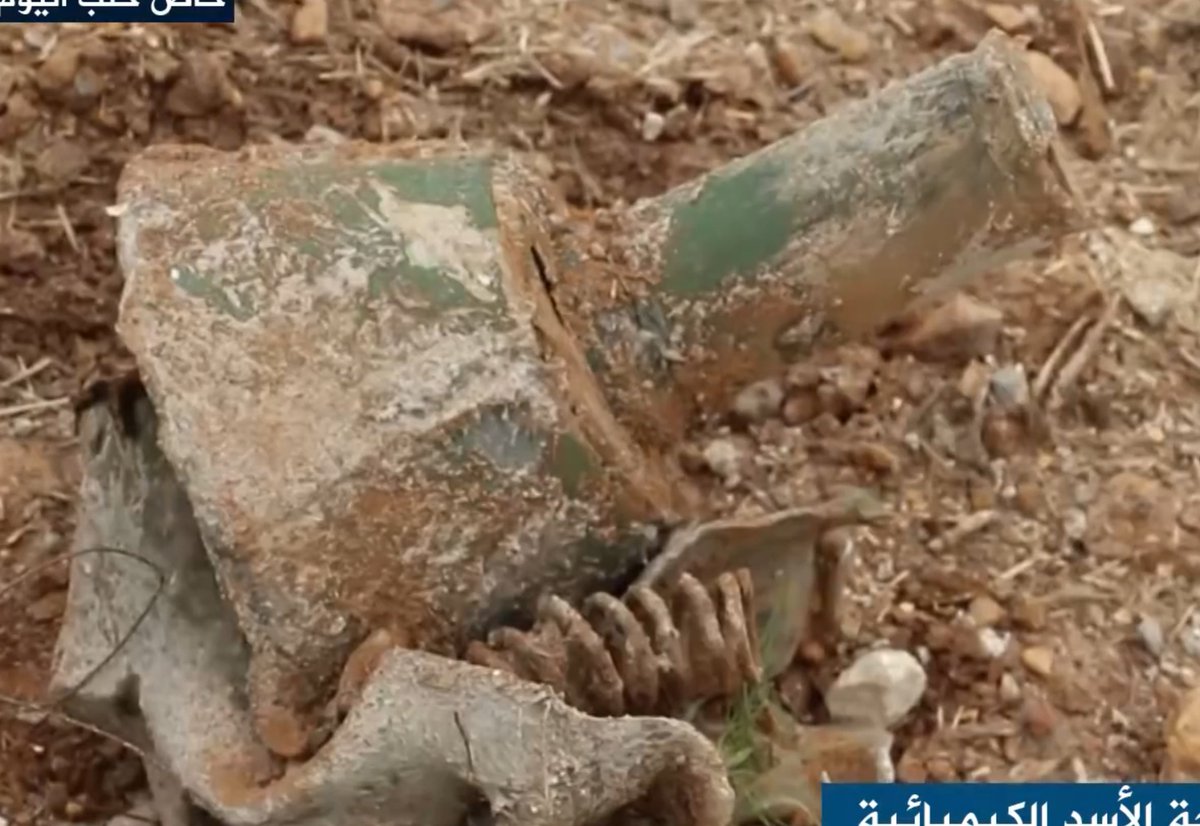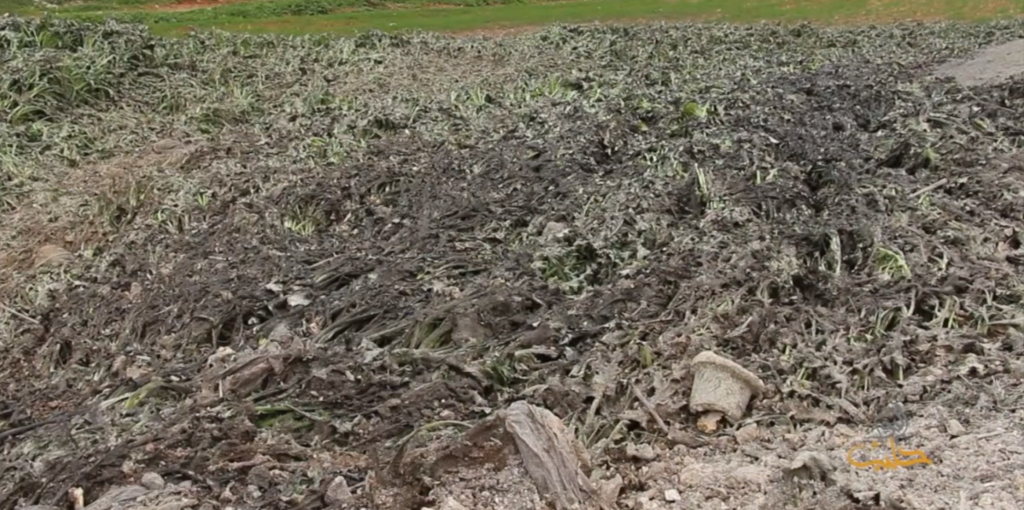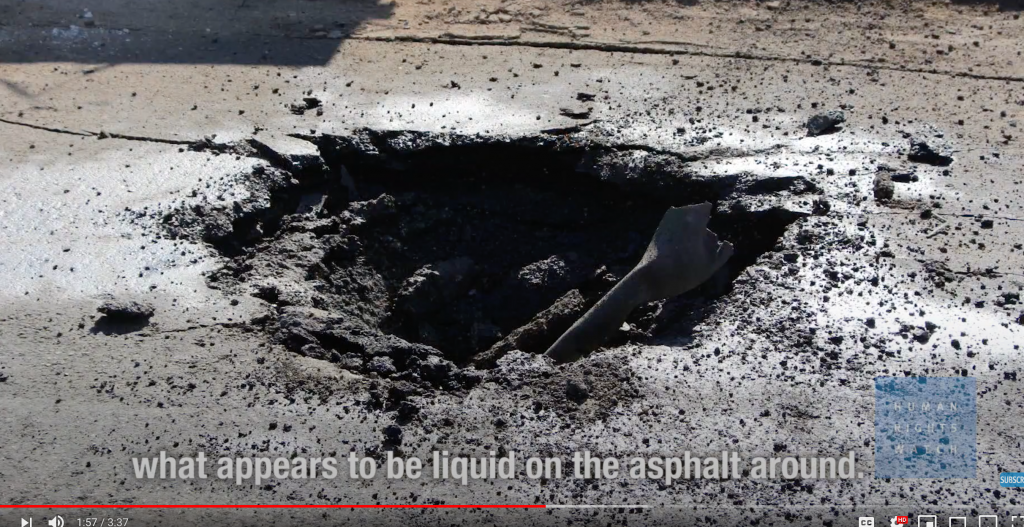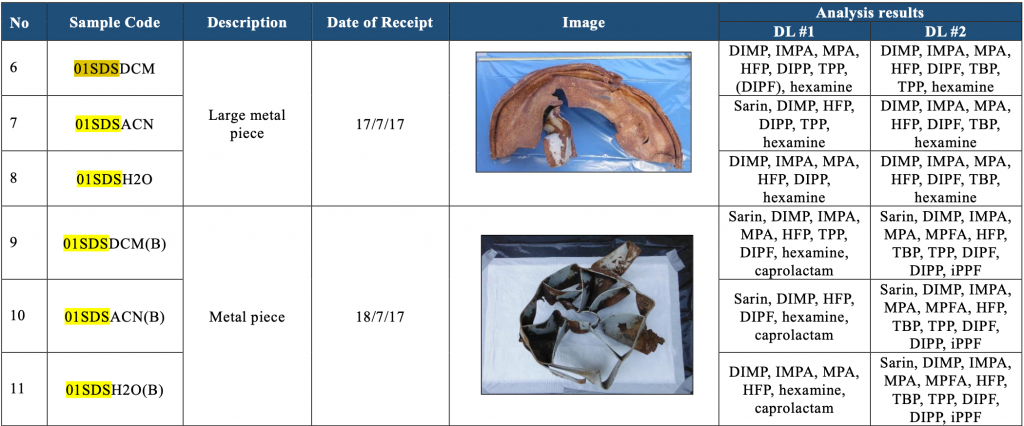Date Report Conceived: April 29, 2020
Date Report Published: July 30, 2023
Executive Summary
All available evidence points to the events at Lataminah on March 30, 2017, as having been staged. Bomb fragments were recorded at the scene that later turned out to be from an M4000 bomb which was one of Syria’s declared aerial chemical munitions. This report will show how evidence of Syria’s chemical arsenal was made known and leaked in August the previous year. The evidence will also point to there being no Sarin in situ at the time of the arrival of the White Helmets. We will present evidence of this group lifting and carrying away with them a “Hazard Warning” sign after the cameras had moved on. The significance of this is that Hazard Warnings signs are to warn of a hazard. To carry the signs away as you and the cameramen leave the scene points to staging.
We will also highlight that whilst those who jump to defend sandal-wearing first responders in Sarin craters with cries of “Sarin is non-persistent!” are the same people that fall silent when it’s shown that Sarin, not just its degradation products, but the active agent, allegedly remained on samples that were left out in the open, at the crater, for up to 15 weeks after the alleged event.
The evidence will show that the events at Lataminah on March 30, 2017, were staged.
Introduction
Oh! What A Tangled Web We Weave When First We Practice To Deceive.
Walter Scott, Historian & Playwright 1808
That quote sums up well the entire debacle that took place in Lataminah from March 24, 2017, to March 30, 2017. Having spent hundreds of hours researching all the claims and counterclaims on what did or didn’t take place and having already written two in-depth reports on the alleged incidents of March 25 and March 30, we will now bring all that together, with new information, in a response to the IIT report of the 8th April 2020.
On March 30, 2017, it is claimed there was a Sarin attack in Lataminah, a town in northern Syria in the Hama Governorate. Supporting this claim the notorious White Helmets offered up fragments of an M4000 Syrian Chemical Bomb recorded at the alleged impact site along with random pieces of unrelated debris such as a cluster munition fragment and pieces of random debris that the FFM failed to mention in their report.
In this report, we look again at what happened at Lataminah on March 30, 2017, in light of the OPCW-IIT report on the same incident. Having previously uncovered footage showing a White Helmet first-responder walking through an allegedly freshly made Sarin crater in a pair of sandals we begin by asking; What is the persistency of Sarin? We ascertain that whilst it has a low persistency, especially outdoors in the natural environment, it would still persist for up to 24 hours after being dispersed in the manner in which we are told it was deployed at Lataminah.
The OPCW-IIT (Investigation and Identification Team) claims that it verified footage that was taken from the alleged crater “a few hours after the attack“. We will show the earliest footage available from the crater and highlight a plethora of discrepancies and oddities in the footage that further supports our conclusion the event was staged.
We revisit the evidence of inappropriately trained and outfitted White Helmet “Chemical Sample Unit” members who are wearing ineffective costumes that, for some footage at least, weren’t fully fastened yet for others, they are. We will show this as being a result of stage management. We also republish the communications from PPE experts on the type of clothing that should be worn and under what circumstances it should be worn.
The IIT claims that an early warning spotter system was in place on the morning of the alleged attack which reported that “an aircraft was heading to the area“. We take a look at Sentry Syria, the official early warning system for the rebels that was set up and run by the White Helmets, and will show that they made no mention of any aircraft inbound on Lataminah on the morning in question.
The IIT also says that it viewed the footage that it “authenticated…as being from the attack“. We review what we believe to be the footage they are referring to and show that this footage couldn’t possibly be from a chemical attack as described.
We will show that for the Sarin to get from the crater to the caves, where it is said to have affected people, would have required it to travel 300m to the north whilst continuing to rise 15m above ground level. This is an important claim as the FFM (Fact-Find Mission) and IIT both claim that Sarin would hug the ground and stay at low levels given the fact that it is heavier than air. So how then in this alleged incident can it travel 300m to the north whilst raising 15m up a hill?
Let’s begin by addressing the question of Sarin’s persistence.
[Before proceeding, we accept that claims of usage of chemical weapons in Syria are a highly contentious matter with strong feelings on all sides of the debate. However, we ask that you set aside your “feelings” whilst reading this report and instead focus on the evidence and what it is showing. Detach yourself from any preconceived ideas, if you can, and follow the evidence.]
Sarin Persistency
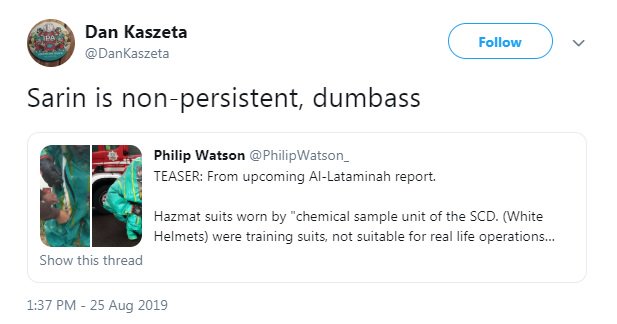
GB (Sarin) is considered to be a non-persistent agent. If released, the liquid would not be expected to stay in the environment for a long period of time. It evaporates at about the same rate as water. Persistency of this agent is mainly dependent on the amount of agent present and weather conditions.
The U.S. Army Chemical Materials Activity (CMA)
Given the fact that Sarin doesn’t stay in the environment long, it is therefore said to be “non-persistent”. This is an argument that is often used by those that insist that the Syrian government is deploying it on the battlefield.
This argument was first introduced after the Khan Sheikhoun incident of April 7, 2017, when a first responder was infamously recorded standing in an alleged Sarin crater in a pair of sandals – with bare feet.
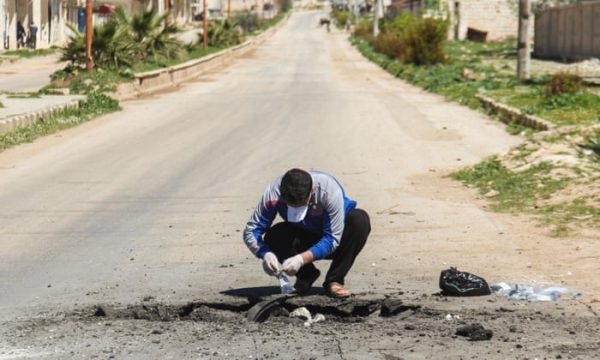
This image created much hysteria for those believing the event was staged who would use it to support their argument that Sarin couldn’t have been used at the scene. This in turn was responded to by the “Assad-done-it” cabal using the “Sarin is non-persistent” rebutal. In deploying this argument they are attempting to explain how someone in sandals could walk into a deadly Sarin crater shortly after it is alleged to have been created.
Fast-forward to April 16, 2020, and we uncovered a video that showed another sandal-wearing White Helmet cameraman in the middle of another alleged Sarin crater that was only a few hours old.
We discuss this revelation elsewhere in this report but for this section, we will be focusing on the matter of Sarin’s persistence, as immediately upon us tweeting the video of the sandals guy above, the same people who argued in defence of the Khan Sheikhoun sandals-wearer were rolled out to provide the same apologia for the guy at the Lataminah crater. So let’s take a look at expert opinion on Sarin’s persistence to educate ourselves a little on the subject matter before moving forward.
The US National Response Team on Sarin
Who are they?
The U.S. National Response Team (NRT) is an organization of 15 Federal departments and agencies responsible for coordinating emergency preparedness and response to oil and hazardous substance pollution incidents. The Environment Protection Agency (EPA) and the U.S. Coast Guard (USCG) serve as Chair and Vice Chair respectively. The National Oil and Hazardous Substances Pollution Contingency Plan (NCP) and the Code of Federal Regulations (40 CFR part 300) outline the role of the NRT and Regional Response Teams (RRTs). The response teams are also cited in various federal statutes, including Superfund Amendments and Reauthorization Act (SARA) – Title III and the Hazardous Materials Transportation Act (HMTA).
Source
What do they say about Sarin’s persistence?
Persistence: GB is considered a “very low persistent” chemical warfare agent. Vapor: minutes to hours; liquid: 2-24 hours. Persistence will depend upon the amount and purity of the agent, method of release, environmental conditions, and the types of surfaces and materials impacted.
GB (Sarin) is expected to degrade in the environment fairly rapidly; however, liquid GB on surfaces could persist for up to 24 hours. Environmental conditions will affect the degradation and evaporation rates of GB with cooler and drier conditions enhancing persistence.
PDF
Given that “black bubbling liquid” was reported in the alleged Sarin crater of March 24 (Lataminah) many days after the alleged attack took place then it’s reasonable to presume that just a few hours after the alleged event at Lataminah on March 30, Sarin would still be present when the sandals wearing White Helmet arrived at the scene.
But how long after the alleged attack was it before the White Helmets and their film crew arrived at the crater?
The IIT obtained video footage of the location confirmed to have been taken a few hours after the attack, matching the description of the area of the crater provided by witnesses as well as the process of sample collection. The IIT further obtained information and images–confirming material considered by the FFM–indicating that vegetation in the area was damaged and discoloured. (Emphasis added)
S/1867/2020 page 48, 9.8
The IIT have, they say, confirmed that the footage recorded at the crater occurred “a few hours after the attack“. (Note they drop the use of the term “alleged” here when they refer to “the attack”.)
What we have so far learned about the persistence of Sarin liquid, it can remain at a location for around 2-24 hrs. So when the White Helmets arrive to investigate such a Sarin-filled crater in “unfit for purpose” GTS (Gas Tight Suits), one of which wasn’t fastened up, whilst another guy walks straight into the crater wearing sandals, this would point to the first responders not being that concerned about they were investigating. Even poor training wouldn’t account for the lack of fear.
But what about Sarin’s persistence in soil?
We carried out further searches on any tests carried out on the permeability of Sarin in soil and came across this PubChem article on Sarin wherein it states:
If released to soil, Sarin is expected to have very high mobility based upon an estimated Koc of 16
What is a “Koc of 16”? We checked this with ChemSafety to ascertain its definition.
Soil adsorption coefficient (Kd) measures the amount of chemical substance adsorbed onto soil per amount of water.
… it is more useful to normalize the Kd or Kf to the organic carbon content of a soil and express the distribution coefficient in Koc or Kfoc.
So in short, Koc is the measurement of how quickly a chemical is absorbed into soil. With regards to the numeration of 16, we found this,

Therefore, Sarin has a very high mobility rating in soil (16), in other words, it doesn’t hang around for long.
The NRT study goes on to say (as also posted above):
Persistence: GB is considered a “very low persistent” chemical warfare agent. Vapor: minutes to hours; liquid: 2-24 hours. Persistence will depend upon the amount and purity of the agent, method of release, environmental conditions, and the types of surfaces and materials impacted.
Open Areas: GB has high volatility relative to other nerve agents but may still be present as a liquid or aerosol, and the primary release/attack scenario is an airborne release. GB is expected to degrade in the environment fairly rapidly; however, liquid GB on surfaces could persist for up to 24 hours. Environmental conditions will affect the degradation and evaporation rates of GB with cooler and drier conditions enhancing persistence. (Emphasis mine)
NRT Sarin Reference Guide
The IIT claims the White Helmets arrived at the scene “a few hours” after the alleged attack is said to have taken place and that they despatched their expert “Chemical Sample Unit” to the scene equipped with Hazmat suits and cameramen so they were, at least wishing to sell the narrative, that they were expecting a serious chemical incident having taken place there.
However, if the ‘chemical sample unit’ arrived at this dangerous site with full PPE, then what made their colleague feel it was OK to wear sandals with bare feet and no PPE?

Gas Tight Suits
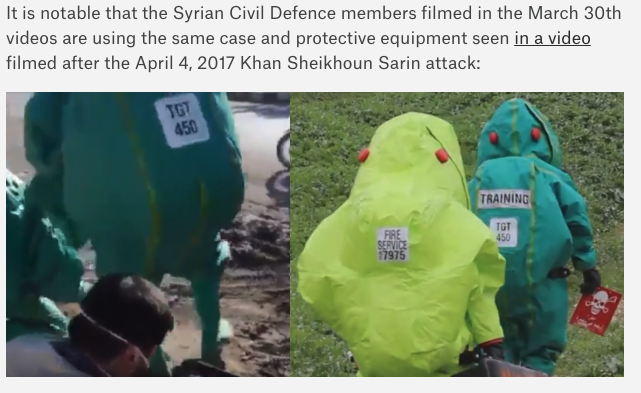
The NRT report also notes:
Per NIOSH guidance – LEVEL A: Recommended for the initial response to a GB incident. Level A provides the greatest level of skin (fully encapsulating suit), respiratory (SCBA), and eye protection when the contaminant identity or concentration is unknown. Select Level A when the GB concentration is unknown
NRT Sarin Reference Guide
The suits worn by the two White Helmets are “fully encapsulating” and thus “Level A” suits, however, they were only Training Suits meaning, they were not safe to use in a real-life chemical event.
We know this because we contacted world leaders in PPE gear, Lakeland EU, for a previous report into Lataminah seeking to gain more awareness of these suits. They in turn put us in touch with one of their experts whom we asked about the suitability of various suits for use in real-life scenarios. This is what they told us (verbatim);
Fully operational Level A suit is the suit ready for work either in regular operations or “in case of emergency”. Each suit has to be regularly inspected visually and pressure tested with proper equipment to make sure it meets the requirements of safety standards. Each Level A suit has defined “shelf life time” which is usually between 5 and 10 years depends on manufacturer. This means you can store the suit in defined conditions and don’t use it in real emergency for even 10 years. Having said that, you still need to make visual inspections and pressure tests with suits on regular basis (which is usually every six months).
Emphasis added.
Training suit is the suit you can use either for training purposes for emergency teams or for presentation purposes for sales people. Training suits are not allowed to use in real emergency situations. They are only demonstration suits and they do not guarantee proper protection against gases. Usually training suits are those which are older than “shelf life time” but have not been damaged or contaminated.
We previously showed how the suits were in fact notably damaged:

We also showed how one costume was in fact left unzipped in an alleged sarin crater.
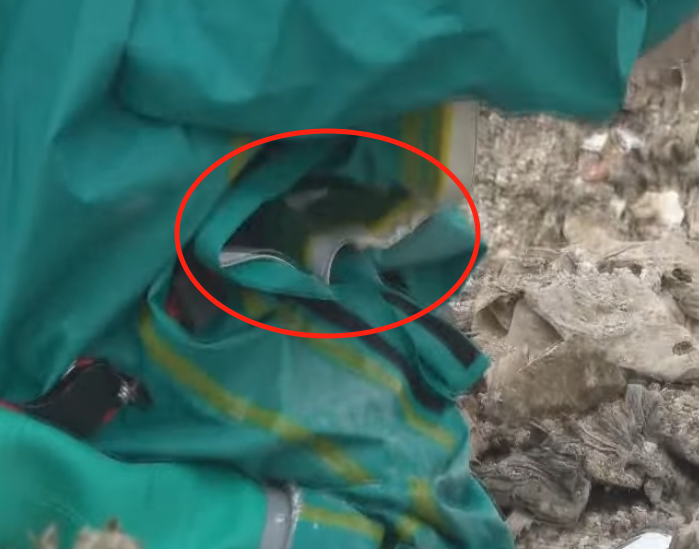
We showed how they were contaminated by highlighting that the same suits that were used on March 30 at Lataminah were then used on April 7 in Khan Sheikhoun.
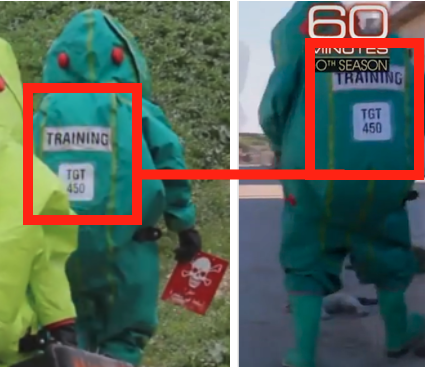
Rising Sarin
Both the IIT and FFM reports point out that given Sarin density it would stay low to the ground:
Sarin vapours are denser than air (and therefore tend to accumulate in low-lying areas);
OPCW-IIT, S/1867/2020, page 24, 6.4
The FFM noted the low wind speed on the day of the allegation which would facilitate the collection of Sarin, being denser than air, in low areas such as underground in caves.
OPCW-FFM Report, S/2017/931, page 26, 6.8
It is claimed that Sarin from the alleged bomb on March 30 affected people in a nearby cave structure, as per both OPCW reports, but for this to happen it would therefore need to become lighter than air and rise approximately 12m whilst travelling 300m away from the alleged impact site. Therefore the Sarin would need to change its chemical structure for the first time in history and take on a whole new level of capability.
To confirm Sarin density I decided to check what Bellingcat’s ‘chemical weapons expert’, Dan Kaszeta, says about it:

4.8 times denser than air? Yet it managed to rise 12m above ground level, outdoors, with the variability of wind patterns.
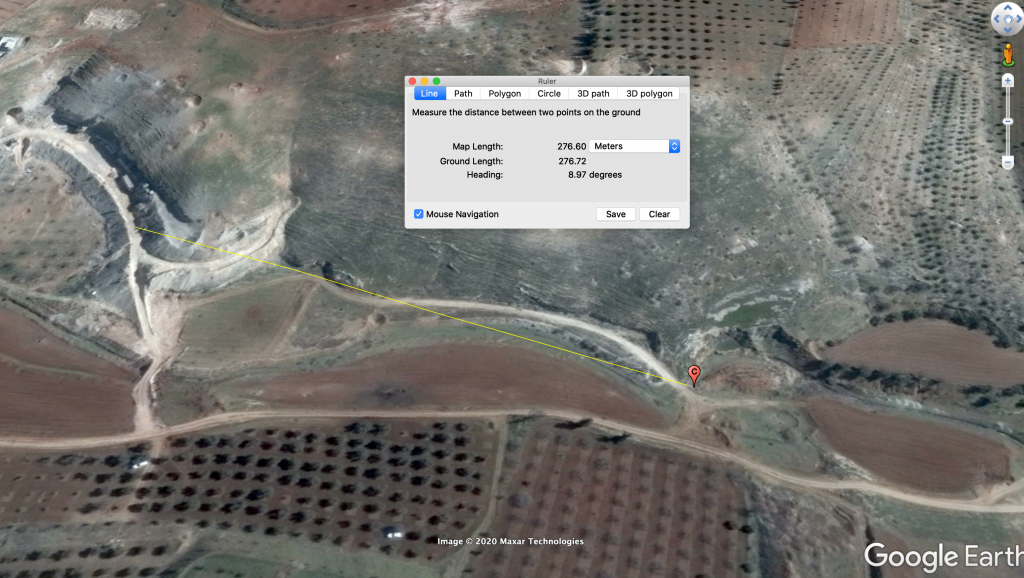
Above is Google Earth imagery measuring the distance from the alleged impact site of the Sarin bomb (C) to the nearby caves which are roughly 280m away to the northwest. You will note the land dips before rising rapidly. Given what we are told about Sarin we should assume it would stay close to the ground. Instead, it had to rise approximately 12m above ground level and travel almost 300m NW in an orderly fashion.
This image gives a better idea of the topography of the land between the crater and the caves.
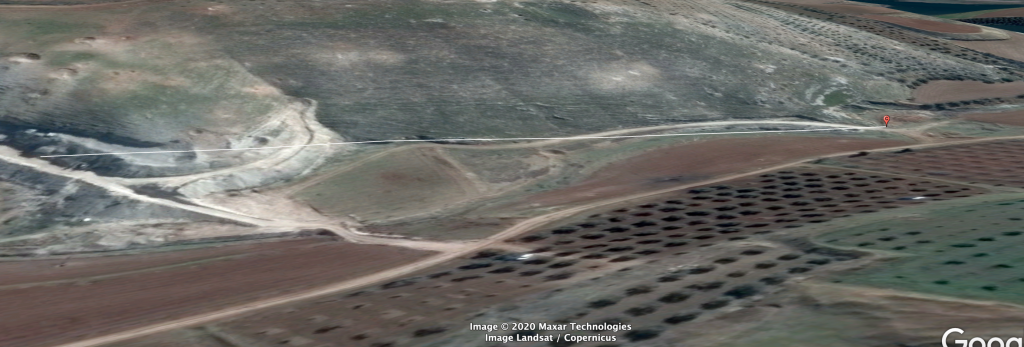
According to the IIT, there were “light winds” on the morning in question. Yet these light winds were strong enough to blow vapourised liquid that is 4.8 times heavier than air, 300m horizontally and 12m upwards.
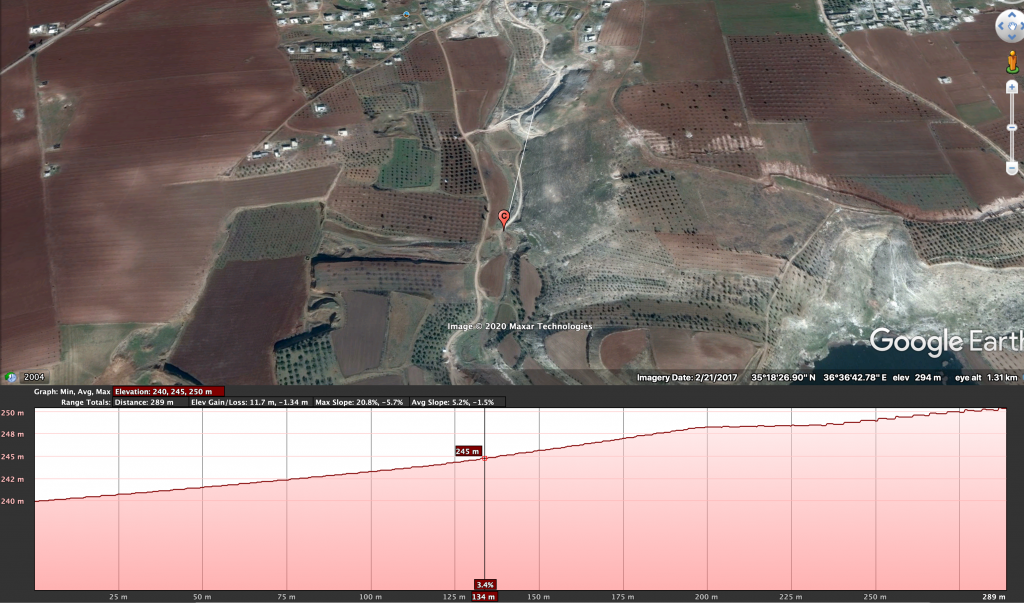
This is the elevation profile between the alleged crater and the nearby caves.
According to the Centres for Disease Control and Prevention (CDC):
Because Sarin vapor is heavier than air, it will sink to low-lying areas and create a greater exposure hazard there.
Source
The CDC goes on to advise:
If the Sarin release was outdoors, move away from the area where the Sarin was released. Go to the highest ground possible, because sarin is heavier than air and will sink to low-lying areas.
Yet the FFM and IIT are claiming that this particular Sarin avoided the low ground and instead rose 12m into the air to find the only cave structure in the area wherein people just so happen to be situated.
Sentry Syria
Sentry Syria is a part of the Western-funded White Helmets project in Syria. In their own words, they are…
A quick warning system that sends quick warnings within seconds of the flight monitoring process and circulates it to civilians in coordination with civilian observatories inside Syria. [translated using Google Translate]
ظام تحذير سريع يقوم بعملية إرسال تحذيرات سريعة خلال ثوانٍ من عملية رصد الطيران وتعميمها على المدنيين بالتنسيق مع مراصد مدنية داخل سوريا.
Direct Translation
They have long acted as an early warning team that alerts rebels on the ground of impending aerial attacks from either the Russian or the Syrian airforces. However, on the morning of March 30, 2017, there are no alerts from the group of any attacks looming on Lataminah.
According to the FFM report on the alleged incident, the aerial attacks began at 06:00 EET or 05:00 GMT+1 (London). The times of the tweets from Sentry Syria are in GMT so add an hour for Hama, Syrian time.
For the time conversion verification, we used World Time Buddy.

Here’s an example. A tweet made at 03:50 Syrian time is recorded as 02:50 (GMT) on 30 March 2017:
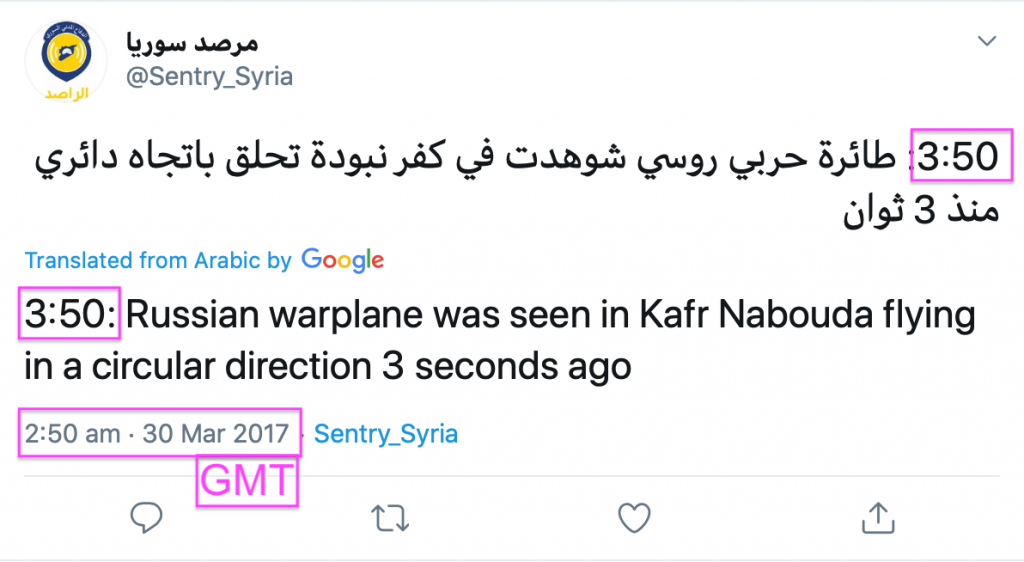
So let’s take a quick look at the tweets they made on or around the time of 06:00 Syrian time on March 30, 2017, the date and time of the alleged event.
This is the search string we used in Twitter:
(from:Sentry_Syria) until:2017-03-31 since:2017-03-30

Being lenient with our times, we decided to focus on this time bracket; from 04:25 Syrian time to 07:43, bear in mind the alleged attack is said to have occurred at 06:00 Syrian time.
Here are the tweets we found from this time window along with translations as per Google Translate:

You will note that the tweet at 06:25 has no location in the direct translation so using our translator they informed us that they believe the town was Al-Zeyarah in Hama Province.
We can see there is no mention of anything being detected heading towards Lataminah in the morning in question. So this begs the question, upon what other early warning systems are the IIT and FFM basing their claims when they say…?
An early warning was heard through the network before the attack, alerting that an aircraft was heading to the area,
OPCW-IIT Report, S/1867/2020, page 47,48, 9.7
As noted, Sentry Syria is the “official” early warning network and they made no mention of it according to our search results. We carried out extensive research for this report and reached out to many Syria watchers and none could find any mention of any aircraft approaching Lataminah on the morning in question.
Mahmod Hamway
In the course of many, many hours of research into Lataminah, we found there was no shortage of footage and imagery showing day and daily attacks on the town and neighbouring areas from what would seem to be aerial bombardments. However, we struggled to find anything from March 30.
We used every spelling variation of Lataminah we could gather and ran extensive searches on Twitter using the following search string,
“(Lataminah OR Ltamenah OR Ltameneh OR Latamina OR Latamneh OR Latamna OR اللطامنة)) until:2017-03-31 since:2017-03-30”
We could only find 2 videos uploaded with the date of March 30.
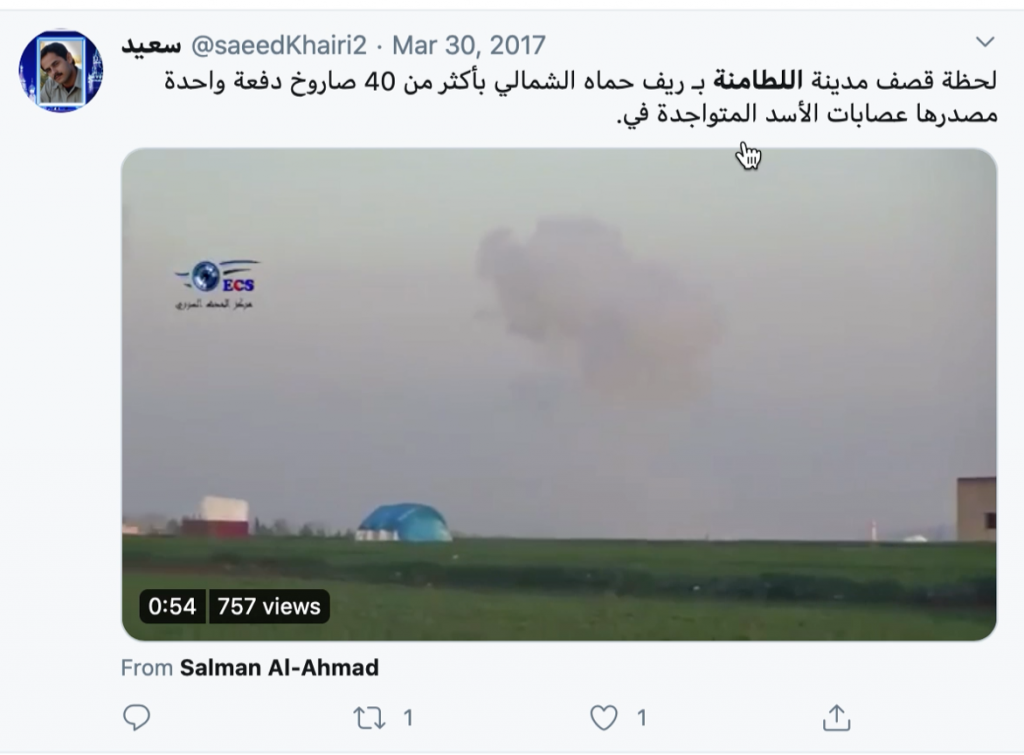
However, the above video was essentially uploaded the previous day:
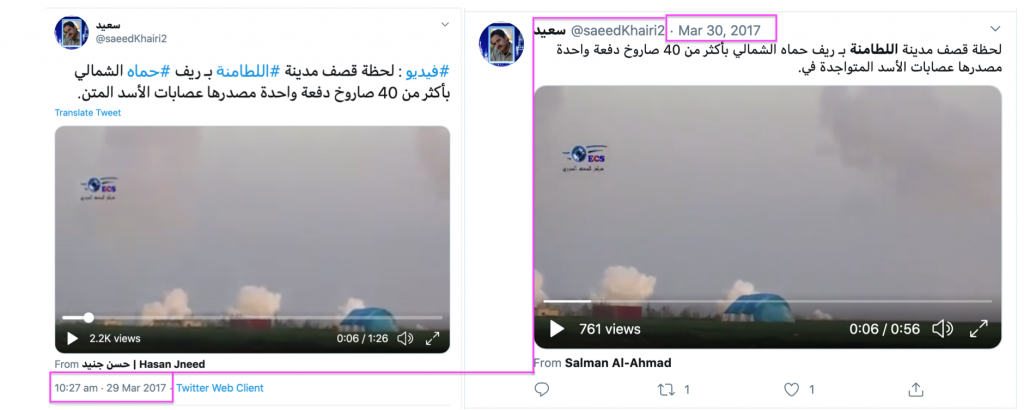
In fact, the only footage that we could find of any alleged attack on Lataminah on March 30 is the footage from a “Mahmod Hamway” as provided by Bellingcat and which we supply here for your information:
Let’s take a look at what the narrator is saying:
Title: Poisonous gases perpetrated by the Military Airforce on the city of Lattamneh, Hama countryside, causing injuries 30-3-2017
Military Airforce bombards the city of Lattamneh in the Hama countryside.
Bombardment by the Military Airforce on the city of Lattamneh in the northern Hama countryside.
At 0:20, inaudible.
30/03/2017 & the Military Airforce remains in the skies overhead.
The Military Airforce remains in the skies overhead
Taking the Hamway video at face value we must then ask the very obvious question – How did Mahmod Hamway know a chemical attack had occurred as he was recording?
The OPCW-IIT report refers to the OPCW-FFM report for the time of the attack as occurring at approximately 06:00 on the morning of March 30, 2017. They also refer to video footage they say they have authenticated which we believe to be the Mahmod video above.
The IIT obtained video footage of an air strike on Ltamenah at around 6:00. The video, authenticated by the IIT as being from the attack of 30 March 2017, shows a grey smoke plume.
S/1867/2020 page 48, 9.11
Mahmoud posted the video on YouTube and although his Twitter account was established in December 2015, we cannot find any searches past July 2019.
Taking the YouTube video we checked its metadata to ascertain the date and time of upload. For this, we used Mattw.io and cross-referenced the findings with another metadata checker from Amnesty International.

The video was uploaded to Youtube at 04:17 (UTC) on March 30, 2017. Bear in mind that London was then UTC+1 therefore 05:17 and Syria was EET (UTC+2) therefore 06:17. To confirm and validate the timezones we used timeanddate.com.

Bellingcat, in their Lataminah report, claimed to have contacted a farmer by the name of Anwar Rahmoun who had been interviewed originally by Human Rights Watch for their report, Death by Chemicals. Rahmoun is alleged to have told Bellingcat the attack happened between “6 to 6:15”.
HRW cited a member of the White Helmets, Abd al-Munaf Faraj al-Saleh, who is alleged to have attended the scene, as claiming the attack took place “about 6:30 a.m.”
So with 4 times being given between 6-6:30 a.m., the median would be 06:15. Therefore, based upon that information, the timing of the Mahmod video, 06:17, is, without doubt, the video the IIT is referring to.
Mahmod’s Camera
As part of this investigation, we decided to look at other footage from Lataminah to see if we could learn who Mahmod Hamway was and if we could get evidence of what camera he uses to record his videos as then we could understand better how he edits and uploads his videos to YouTube.
In footage from 16 March 2017, we spotted Mahmod holding a camera.
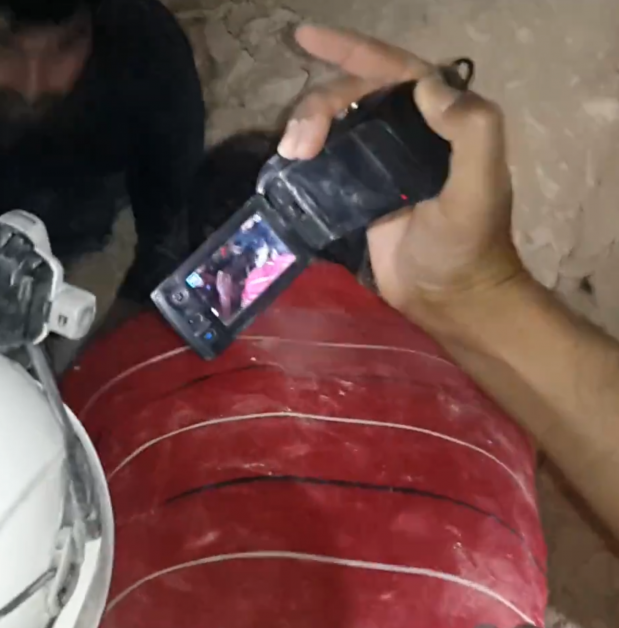
We put the call out on Twitter seeking help identifying the camera and within minutes we had an ID.
It wasn’t long until we found footage of Mahmod with his camera and laptop.
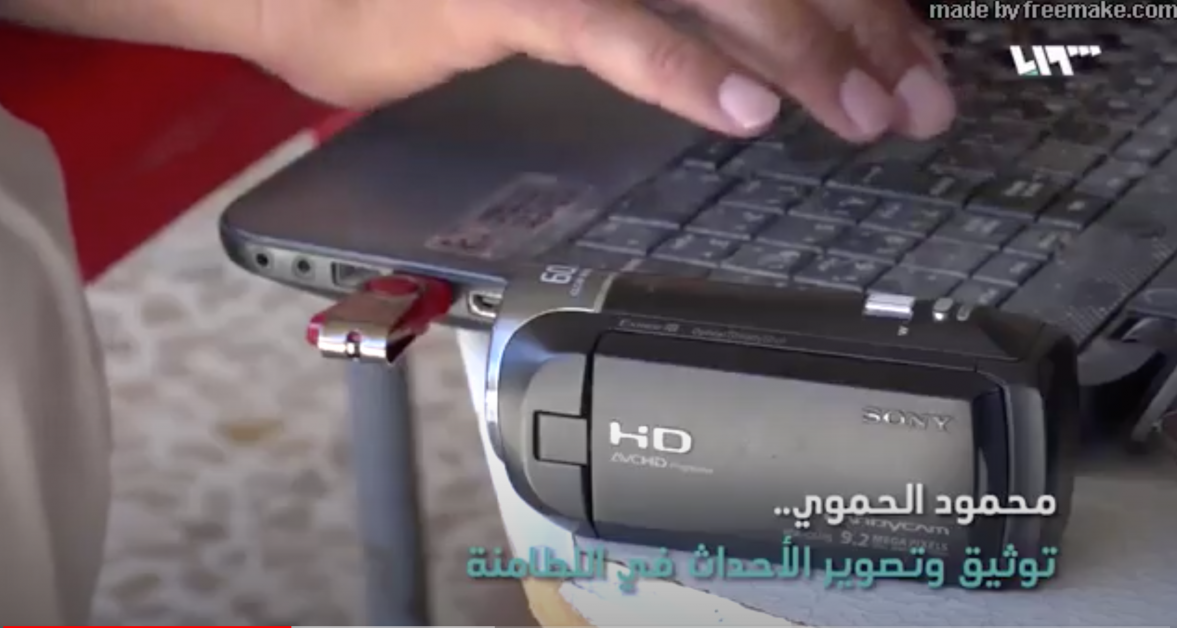
The camera has no Bluetooth or wifi capability so it needs to be connected to the laptop via USB as only then a file transfer can be possible. Assuming the video file doesn’t require editing of any description, including size adjustment etc, then from the laptop the video would be uploaded to YouTube providing an internet connection is available.
The question now arises, would Mahmod have sat on the roof with his laptop at 6 am, connected his camera to it, transferred files and then uploaded to Youtube along with the voiceover, and all this relying on internet access of course, whilst airstrikes were raining down around him?
OPCW-IIT Timings
Worth also noting at this stage that the IIT referred to the “Independent International Commission of Inquiry on the Syrian Arab Republic” (IICISyria) in the same paragraph when they spoke of the 06:00 video:
Moreover, the Independent International Commission of Inquiry on the Syrian Arab Republic, which investigated the same incident, found that the bomb related to this incident made almost no sound and released a material without any particular smell.
S/1867/2020 page 48, 9.11
Following their reference to the IICISyria report and to the aforementioned section we arrive at this statement,
At around 6.30 a.m. on 30 March — five days after the chlorine attack on Al- Latamneh hospital by Syrian forces (see para. 64 above) — an unidentified warplane dropped two bombs in an agricultural field south of Al-Latamneh village.
A/HRC/36/55, paragraph 69
Whilst the IIT leans on the IICISyria to help support a part of their claim they seem quite happy to ignore the fact the latter report contradicts their findings on both the time of the alleged attack and the number of bombs dropped. The IIT claims a 6:00 a.m. start time for 4 bombs being dropped whereas the IICISyria claims a 6:30 a.m. start time for 2 bombs being dropped.
Assuming the attack took place at the earliest time given of 06:00 and assuming Mahmod just happened to be up at the right time in the morning, in the right place and have his camera focused on the right spot, assuming all that is true, how did he know the bomb contained “poisonous gas” as it hit the ground?
Also note, that isn’t a camera phone he’s using, the zoom and image quality is too great. So if we assume again that he’s using a DSLR with wireless or Bluetooth connectivity meaning he could transfer the footage straight to his phone. We would also have to allow time for that to happen and given the video was likely to have been longer and cut down to size there would have been editing involved too. We also need to take into consideration the upload and processing time of the video from the camera to YouTube.
Would Mahmod have sat on the roof and carried out all those tasks immediately after recording them and as aerial attacks are alleged to be taking place? Unlikely, but possible.
With all that said, we ask the pivotal question again: How did Mahmod know the bomb dropped was a chemical bomb as he recorded it, supposedly, live? And again we must ask, why was there no mention of this aircraft over Lataminah from Sentry Syria?
The IIT report:
Witnesses to the event described one of the detonations they heard as having a “different, quieter” sound than the three other impacts they heard, with no odour and causing no visible smoke. (Emphasis added)
S/1867/2020 page 47; 9.7
Going by that the blast recorded by Mahmod showing a large plume of smoke it could not have been of a chemical bomb as that is referred to as having “no visible smoke” by the witnesses, none of whom actually saw any of the bombs dropping:
Witnesses describe being in nearby caves at the time of the passing plane and subsequent detonations. None of the witnesses interviewed saw the planes drop munitions in their area.
OPCW-FFM Report, S/2017/931, page 11, 5.13
The FFM said in their report:
The third detonation had a different, quieter, characteristic than the other three, with no odour and associated smoke being unlike other attacks.
S/2017/931 page 11; 5.14
So it is claimed it was the third (quieter) detonation that was the chemical bomb so it follows that Mahmod must have recorded the 4th detonation of a HE (high explosive) bomb for him to have claimed a chemical attack had just occurred. Unless of course he was playing an active part in the staging narrative and his voice was overdubbed onto a random recording of an explosion and uploaded to YouTube at the required time.
Breaking that all down, let’s suggest a very generous timeframe of around 10 minutes for him to transfer the footage to his phone from the camera, edit it, upload it and for YouTube to process it. It went live at 06:17 so that would suggest the 4 bombs were dropped in a 7 minute window. Let me expand on this a little to remove any doubt in the scenario that is being sold by the OPCW here.
The FFM said there were four bombs dropped but the third was “quieter…with no odour [or] associated smoke“. Though the FFM also says that “None of the witnesses saw the planes drop munitions” – so how did they know one bomb left no smoke? I digress.
This would mean they are suggesting that the third bomb was the chemical bomb however Mahmod recorded an explosion that did give rise to a plume of smoke whilst also claiming a chemical attack had just taken place. Therefore, taking Mahmod’s narrative as genuine, he must have recorded the fourth and last bomb that followed the “quieter” chemical bomb.
Assuming, again, he recorded the last bomb dropping at 06:07 and the earliest time for the attack given was 06:00 then we are to believe in a period of 7 minutes a chemical bomb was dropped in a field, determined to be a chemical bomb and word sent out that it was a chemical bomb. It so happened that as word was sent out it was a chemical attack Mahmod just happened to be on a roof, with his camera pointing in the exact direction the attack was about to take place. None of this makes any sense yet the world’s leading chemical weapons watchdog, the OPCW, is asking that you believe this is exactly what occurred.
Narrative Timeline
Some reiteration for clarity follows.
The IIT points to the FFM report wherein “witnesses” claimed there were 4 bombs dropped and whilst nobody witnessed the bombs being dropped, it was claimed;
“The third detonation had a different, quieter, characteristic than the other three, with no odour and associated smoke, being unlike other attacks.
S/2017/931 page 11, 5.14, OPCW-FFM Report
These same witnesses gave an approximate time of 06:00 for the attack to the FFM that the IIT repeated. However, the IIT points to the Independent International Commission of Inquiry on the Syrian Arab Republic (IICISyria) and their report of A/HRC/36/55 and in particular paragraph 69 of the same report.
69. At around 6.30 a.m. on 30 March — five days after the chlorine attack on Al-Latamneh hospital by Syrian forces (see para. 64 above) — an unidentified warplane dropped two bombs in an agricultural field south of Al-Latamneh village. Interviewees recalled how the first bomb made almost no sound but released a “toxic material” absent any particular smell, while the second bomb caused a loud explosion.
A/HRC/36/55 page 14, paragraph 69
Comparing the different narratives is interesting. As the IIT & FFM “witnesses” gave a time of 06:00 whilst the IICISyria “witnesses” gave a time of 06:30. The FFM/IIT “witnesses” claim 4 bombs of which the third was quieter. The IICISyria “witnesses” speak of 2 bombs with the second being quieter.
Does it really matter how many bombs were dropped? It does when looking at the credibility of the various witnesses and their narratives. Taken in isolation you could argue the number of bombs isn’t important but when viewed collectively, with all the available evidence, this conflicting information becomes important.
The M4000 Timeline
On November 2, 2017, the Russian MOD held a press conference where they presented slides of Syria’s aerial chemical munitions in the form of schematics. They described two such munitions – the MYM6000 and the M4000. This was the first time the names of these munitions became widely known. However, the M4000 had previously been made known to Colum Lynch of Foreign Policy magazine who learned about them from a leaked OPCW DAT (Declaration Assessment Team) report of Syria’s chemical arsenal that was passed to him by the US representative to the OPCW.
In an August 31, 2016 article entitled “The World May Never Know if Syria Really Destroyed All Its Chemical Weapons” Colum wrote about an “M400” aerial chemical bomb where he claimed the information he had came from a “highly confidential, 75-page report by the Organisation for the Prohibition of Chemical Weapons (OPCW) reviewed exclusively by Foreign Policy.” We contacted Colum who confirmed “M400” was in fact a typo and that he was referring to the “M4000”.
It’s important to bear in mind at this stage that Colum saw the leaked report prior to August 31, 2016 – the date of his FP article. The 75-page report was given to the member states in July 2016. Lataminah then occurred in March 2017. Therefore the “highly classified” details of Syria’s chemical arsenal declarations were known 8 months prior to M4000 remnants being found at Lataminah.
The report in question was from the Declarations Assessment Team (DAT) of the OPCW and summarised by the then-Turkish Director General of the OPCW, Ahmet Uzumcu. It is our understanding that Colum received the leaked report from the US mission at the OPCW. Worth also bearing in mind that the Turks were then at war with Syria and the Director General at this time was a Turk. The US was and is still at war with Syria too.
Eight months after the 75-page DAT report was released to member states and eight months after one of those member states leaked the report to Foreign Policy, the remnants of an M4000 were found at Lataminah. This was the first time Syria had been accused of using an aerial munition to deliver Sarin.
Robert Trafford of Forensic Architecture confirmed to me in an email of August 21, 2019, that Eliot Higgins of the US State Department-funded Bellingcat, in preparation for his debate with Professor Theodore Postol of MIT on October 20, 2018, had commissioned Forensic Architecture to model selective debris found at the alleged Lataminah impact site with the Russian schematic of the M4000 chemical bomb. The idea was to strengthen Higgins’ position going into the debate whilst stacking the cards very much against Postol. Incidentally, Forensic Architecture is funded by Goldsmiths University where the debate was being held.
That said, in the email exchange Trafford informed us that Gregory Koblentz had provided him with information on the specifications of the M4000 that he had obtained from a “closed source”. At the time we were advised that Len Phillips, ex-OPCW-FFM Team Leader, had been in communication with Higgins and Koblentz. That source informed us that Koblentz was the source confirming the M4000 specs to both Higgins and Forensic Architecture. When Trafford confirmed his communication with Koblentz this in turn confirmed our source’s info to us.
After the IIT report, we were informed that Koblentz received the M4000 specs from Colum Lynch of FP. Our own Philip Watson went back to Lynch and put the accusation to him in an email dated April 26.
I’m about to write up a report on new findings that have come to light regarding the whole M4000 Lataminah incident and the leaked DAT information obtained by yourself. I have been informed that the information from the DAT leaks made its way to Gregory Koblentz and then onto both Bellingcat and Forensic Architecture and before running with the claim I obviously wanted to run it by you first.
Did you have communications with Gregory Koblentz in relation to the M4000 and/or any other aspects of the leaked DAT information?
The same day Colum responded:
Hi Philip,
Thanks for heads up. I’ll take a pass.
Best
Colum
We were told privately by someone close to Forensic Architecture and Eliot Higgins –
Postol never stood a chance, and that was by design, with a lot of hands on the controls to ensure that was the outcome. It was very much a joint effort from Higgins and Forensic Architecture to go after Postol. He walked into a trap. A trap that Goldsmiths helped set.
DAT Report via Turkey to White Helmets
The same source who informed us that Colum Lynch fed the details of the M4000 to Koblentz went on to say the following,
Why do you think there had there been no reports of an aerial sarin bomb prior to March 2017? War began in 2011. DAT released report to state parties in July 2016 and 8 months later it is alleged that Syria dropped 3xM4000s over the period of 2 weeks having never been charged with dropping an aerial chemical before before or after that date?
The staging of Lataminah began in July 2016 when the US got hold of Syria’s declarations. The March 30 event failed due to lack of casualties. But when it failed it took with it all of the physical evidence gathered of an M4000 for a staging bar a single filler cap that never made its way to the OPCW anyway. That would then be dropped in the crater at Khan Sheikhoun. It ended up in the hands of HRW and from there disappeared.
The Grayzone published information from “OPCW Insiders” when they claim:
The middlemen, representing some so-called NGOs that have been known to coordinate and coach the opposition groups and OPCW inspectors throughout the follow-up on these incidents, have reportedly been a couple of well-known British military figureheads. The narratives, the witness accounts, the soil samples, the metal fragments, the photographs and videos; every item of so-called “evidence” had been provided by those who have everything to gain by implicating their enemies in a chemical attack.
Source
The date of the Grayzone report is April 28, 2020. In December of the previous year, and even further back, we had been tweeting about information received linking Hamish de-Bretton Gordon to chemical weapons in Syria, specifically Lataminah.
Hamish’s bio reads as follows:
A former soldier, he was commanding officer of the UK Chemical, Biological, Radiological and Nuclear (CBRN) Regiment and Nato’s Rapid Reaction CBRN Battalion.
The Turkish Connection
The FFM (Core) Team Leader was Len Phillips who was based in Turkey. Len vehemently dislikes the Syrian government. He is not by any stretch an impartial source and his role as an Inspections Team Leader in Syria for the OPCW gives one a good insight into just how politically hijacked the organisation has become. The inspectors that went to Douma were effectively stood down whilst Len’s team in Turkey wrote the report, interviewed the “witnesses” and took delivery of the samples, contaminated by Sarin.
the FFM…received environmental samples, including munition parts, in a neighbouring country.
FFM Report S/2017/931 page 3, 1.2
Len meet regularly with the late James Le Mesurier in Turkey and together they selected the White Helmet members that would go forward to be interviewed by Len’s “Alpha” team for the FFM report. It was via Le Mesurier that White Helmets were instructed on what samples the OPCW would require and which remnants they needed to collect.
Through liaison with representatives of several NGOs including…the Syrian Civil Defence (also known as White Helmets (SCD)..the FFM identified several witnesses to be interviewed. These witnesses were expected to provide testimony and potentially relevant evidence.
S/2017/931 page 6, 4.7
This claim has also been made by the Working Group on Media, Propaganda and Syria:
These investigations were based on interviews with White Helmets in Turkey and materials that they provided. We have been told that Phillips met regularly in Turkey with James Le Mesurier, founder of the White Helmets.
How the OPCW’s investigation of the Douma incident was nobbled*, June 2019
We wrote about this previously. We were also told that another person Len met with regularly in Turkey was Hamish de-Bretton Gordon. They would go on to set up a consultancy firm under the name of “PHBG Consultants”.
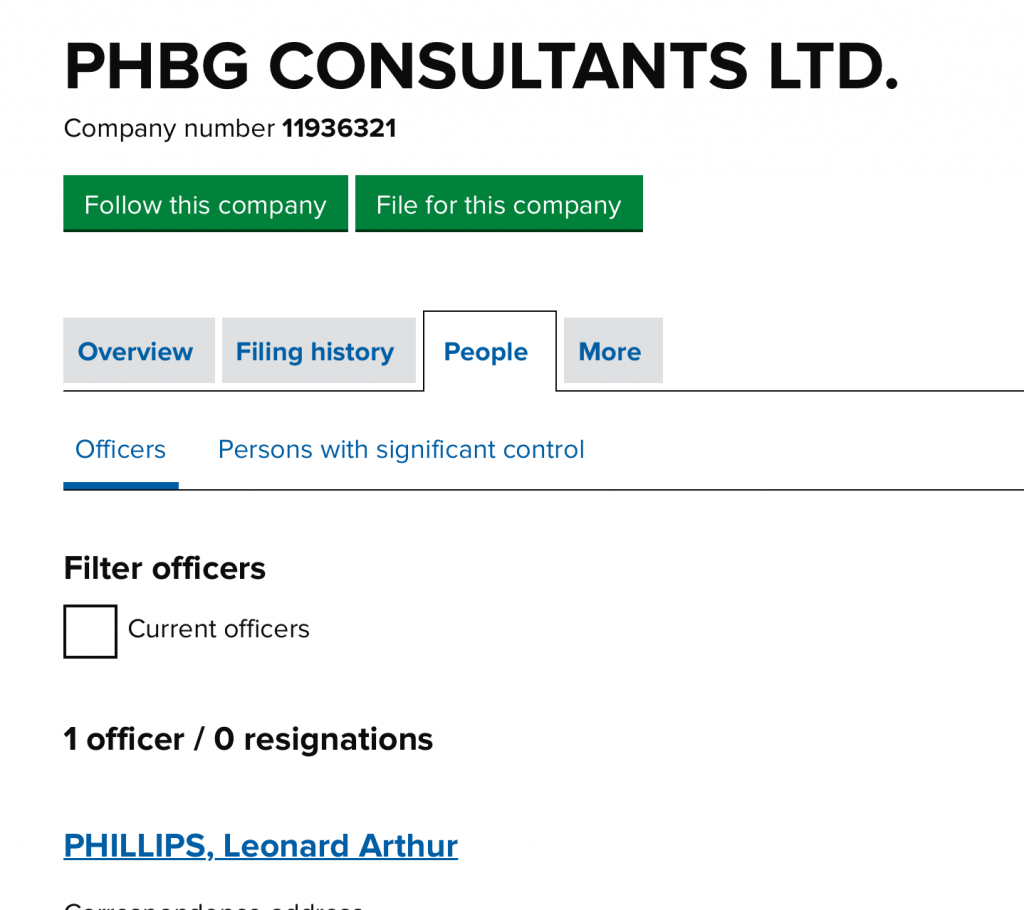
PH = Phillips
BG = Bretton Gordon
Hamish was the point guy for British Intelligence and he looked after ‘all things Sarin in nature’, we were told at the time. The samples left Lataminah uncontaminated and after arriving in Turkey via the White Helmets, they would then be handed over to Hamish and his team. The samples would then be contaminated and returned to the White Helmets to present to Phillips and his team. Phillips would be aware of the process and work from a position of, “See no Evil. Hear no Evil.”
IIT & Their Evidence
Videos obtained by the IIT and authenticated by a forensic institute as being footage from 30 March 2017 show two fragments (01SDS and 07SDS) as not corroded on that date, while the same items are clearly corroded in later images (taken on 5 July 2017). In this respect, similarly to the tail fin (01SDS(B)), the IIT confirmed that both these fragments were collected from the site of the 30 March 2017 attack, based on interviews and geolocation data obtained from digital forensics analysis.
S/1867/2020 page 50, 9.21
The two fragments in question are as follows:
01SDS and 07SDS
You will be aware there are two remnants with the denotations of “01SDS” and two separate dates for their alleged handover to the FFM. The fact the IIT didn’t clarify which of the two pieces they were referring to is representative of their report overall. They employ a lot of smoke and mirrors and hope that they can befuddle the reader enough that they are forced to conclude that this is all over their heads and therefore accept what ‘the experts’ are saying. When in fact this is a fraudulent report from start to finish.
However, using a little process of elimination it’s possible to arrive at an educated guess of which of the two fragments they are referring to. You will see that 01SDSDCM was handed over to the FFM on 17 July 2017. If we look at the handover date for 07SDS it was also 17 July 2017.
But here’s when it gets interesting. The incident is alleged to have occurred on March 30. These pieces of debris were handed over on July 17. Over 15 weeks later. Yet, according to the FFM report they were handed “Soil samples relating to the allegation of 30 March 2017 ” on April 12. We will draw your attention to the phrasing of that statement again:

“Soil samples relating to..” not “Soil samples from..”. That’s intriguing. But that isn’t the main concern. The fact is that whilst soil samples were apparently handed over to the FFM on April 10, it was a further 14 weeks before the two aforementioned remnants made their way to the team. As we will show in the video supplement to this report (coming soon), munition fragments were filmed at the site on the alleged March 30 incident. The fragments were deemed important enough to film but, as it seems, not important enough to collect. Instead, we are told the “Chemical Sample Unit” of the White Helmets, visited the alleged impact site, recorded bomb remnants but left them and instead collected soil samples. Upon handing the soil samples over to the FFM they then instructed the White Helmets to go back to the site and collect the remnants they previously forgot which were then handed over to the FFM months later.
Conclusion
This report is several years late for a number of reasons, the main one being that we have been focused on the Covid pandemic and the unjustified repressive restrictions imposed on us all by authoritarian-leaning politicians and unelected bureaucrats. Given that Covid-cultism is subsiding this has freed us up to focus on completing this study and working towards the completion of others.
Whilst it is 3+ years late we still felt it important to complete, even if only to register our findings on the historical record as we don’t expect, given the time passed, that it will generate much attention.
The report is lengthy and detailed as we always seek to leave no stone unturned in our investigations and we also seek to present them in a manner that is easy to follow and where the reader has access to all the evidence we are using so they can feel confident in our work.
In conclusion, the OPCW-IIT report and investigation on the alleged Sarin attack in Lataminah on 30 March 2017 are fraudulent from beginning to end. They set out to prove a conclusion rather than seeking to gather evidence and allow it to direct their findings.
You are asked to believe that for the first time in history, Sarin changed its chemical makeup and became lighter than air so that it could float up the side of a hill and enter a cave where people were gathered and whilst nobody died from this deadly chemical some took sick. We are also asked to believe that whilst nobody saw the bombs landing, the IIT were able to claim that one of them had no odour or smoke related to its impact. Some accounts say 4 bombs were dropped, some say 2 but nobody saw just how many exactly.
You are asked to believe that a man on a roof at 6 am, just so happened to be recording the exact spot that a bomb dropped in a distant field that so happened to be the field where a chemical bomb was dropped at that very same time. We are also asked to believe that this photographer knew instantly that it was a chemical bomb even though he was several miles away from the impact zone and that he was able to immediately connect his camera to his laptop and upload the footage to YouTube whilst also adding a voiceover as the upload was taking place.
The OPCW claims that the early warning system picked up on an incoming aerial threat to Lataminah whilst we show that the early warning system made no mention of any aerial threat to the town that morning. Why didn’t the IIT supply the evidence for this claim? Because it didn’t happen. They made it up.
Acknowledgements:
Special thanks to Doug Carson and Avryl Connolly for sourcing and cross-referencing and huge thanks to the very brilliant OSINT expert James Clifford for keeping us focused and ensuring that we went back and completed the investigation.
The report was written by Philip Watson and edited by Adam Gershaw.
